One of the ironies of a visit to Hanoi is the importance here of Ho Chi Minh, the founding father of the modern Vietnam. What’s ironic (at least to me) is that he is so strongly identified with Hanoi–yet his legacy is a city 1,000 miles from here (Saigon), where he was less well identified (and I suspect–though a lot of time has passed), less well revered.
We had about three hours between getting to the hotel, having a Pho breakfast (that was my choice, anyway), and departing for two of the Ho Chi 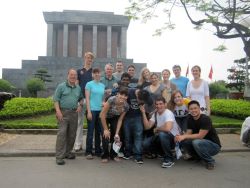 Minh sites. One is the somber mausoleum. Born in 1890, Bac Ho (uncle Ho)’s career took him to Paris and the United States (as kitchen help) and back to Vietnam as an avid nationalist, which essentially meant anti-French. With the Communist Party legal in France, he became steeped in Lenin’s Imperialism, “The Highest Stage of Capitalism,” and founded the Communist Party in Vietnam. At the end of WWII, he declared the independence of Vietnam from France, which united the whole country–for about a month. The French effort to retain power lasted a decade; then the American effort to prop up South Vietnam as a Christian/Capitalist bastion lasted until we pulled out troops in 1972, and witnessed the North’s slicing through South Vietnam, ending in the unification of the country on April 30, 1975. By that point in time, Ho was dead, having expired in 1969. His body was flown to Moscow, to be embalmed by the (I think) Bulgarians who had done Lenin and would later embalm Mao, housed in a tomb in the old French government quarter. As I said, the chamber is somber, and unlike the similar one for Mao, there is no souvenir mall at the exit.
Minh sites. One is the somber mausoleum. Born in 1890, Bac Ho (uncle Ho)’s career took him to Paris and the United States (as kitchen help) and back to Vietnam as an avid nationalist, which essentially meant anti-French. With the Communist Party legal in France, he became steeped in Lenin’s Imperialism, “The Highest Stage of Capitalism,” and founded the Communist Party in Vietnam. At the end of WWII, he declared the independence of Vietnam from France, which united the whole country–for about a month. The French effort to retain power lasted a decade; then the American effort to prop up South Vietnam as a Christian/Capitalist bastion lasted until we pulled out troops in 1972, and witnessed the North’s slicing through South Vietnam, ending in the unification of the country on April 30, 1975. By that point in time, Ho was dead, having expired in 1969. His body was flown to Moscow, to be embalmed by the (I think) Bulgarians who had done Lenin and would later embalm Mao, housed in a tomb in the old French government quarter. As I said, the chamber is somber, and unlike the similar one for Mao, there is no souvenir mall at the exit.
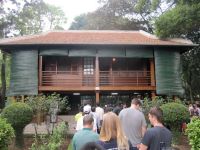 The queue then winds its way to the simple house that Bac Ho built, rather than occupying the palace of the former governor general of Indochina. It’s three rooms, on stilts, near to the mausoleum.
The queue then winds its way to the simple house that Bac Ho built, rather than occupying the palace of the former governor general of Indochina. It’s three rooms, on stilts, near to the mausoleum.
The other visits today emphasized the heritage of Vietnam as within the Chinese sphere of influence: the famous one-pillar pagoda, built a millennium ago (Hanoi celebrated 1,000 years as a city last year, having 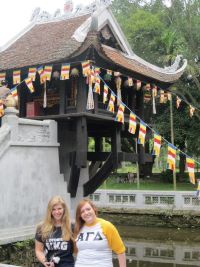 been founded as a dragon city in 1010, supposedly on October 10); the equally ancient pagoda on one of the lakes (where Sen. McLain was shot down in 1969), erected by the first emperor to beat the “feudal Chinese aggressors,” and the lustrous National Museum (couldn’t believe I’d not been there before) with its excellent collection of Cham art, and some really nice items from the Nguyen dynasty (in the 18th-19th centuries).
been founded as a dragon city in 1010, supposedly on October 10); the equally ancient pagoda on one of the lakes (where Sen. McLain was shot down in 1969), erected by the first emperor to beat the “feudal Chinese aggressors,” and the lustrous National Museum (couldn’t believe I’d not been there before) with its excellent collection of Cham art, and some really nice items from the Nguyen dynasty (in the 18th-19th centuries).
The highlight is the Temple of Literature–the Confucian temple in Hanoi, with its stone steles detailing the achievements of scholars (by definition, those who had mastered the Confucian classics, and topped their classes in the exams, which gave them the right to rule under the emperor). That the Chinese culture came so far from Xi’an, or even Beijing, and impacted 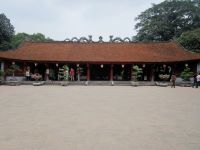 imperial lives here, is a testimony to its power. As I mentioned, Chinese characters were used until Portuguese missionaries gave Vietnam an alphabet.
imperial lives here, is a testimony to its power. As I mentioned, Chinese characters were used until Portuguese missionaries gave Vietnam an alphabet.
We had the afternoon to wander the city (or recover from a train ride; the best part of a 33-hour train ride is hour 34!), and Hanoi is a city made for wandering. Half the size of Saigon, the streets are half as wide in the old town; the jumble of guild streets and shops and motorbikes and cars and horns make it a colorful place to lose an afternoon, or get lost for an afternoon. Sidewalks are for parking bikes.
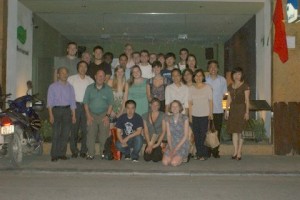 We had an IWU gathering in Hanoi tonight that I bet was the largest gathering of IWU-related people in the city’s 1001-year history. In addition to our 15 students, we invited parents of our students from Hanoi. Eight showed up, not including one sister who now knows more freshmen at IWU than possibly any other member of her class (she enters in the fall), and the younger brother (2nd eldest I think he described himself as) of one of my advisees. Jim and I sat with the parents (and the translator), while the young people conversed. I really hope we’ll be able to
We had an IWU gathering in Hanoi tonight that I bet was the largest gathering of IWU-related people in the city’s 1001-year history. In addition to our 15 students, we invited parents of our students from Hanoi. Eight showed up, not including one sister who now knows more freshmen at IWU than possibly any other member of her class (she enters in the fall), and the younger brother (2nd eldest I think he described himself as) of one of my advisees. Jim and I sat with the parents (and the translator), while the young people conversed. I really hope we’ll be able to 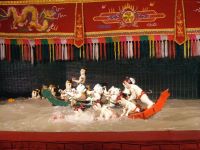 visit again when they come to graduation next spring. The dinner, incidentally, reminded me that Vietnamese food is among the best in the world.
visit again when they come to graduation next spring. The dinner, incidentally, reminded me that Vietnamese food is among the best in the world.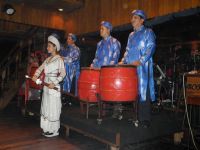 Among other treats (other than the superb rice-wrapped spring rolls), we had shredded chicken banana blossom salad with shrimp chip, and caramelized basa fish in clay pot. Yum.
Among other treats (other than the superb rice-wrapped spring rolls), we had shredded chicken banana blossom salad with shrimp chip, and caramelized basa fish in clay pot. Yum.
Our 26-hour visit to Hanoi, crammed with interesting things, comes to an end tomorrow when we leave the hotel at 7:40 a.m. for the ride to the airport and then the nearly two-hour flight to Hong Kong.
Not sure I told you what’s the best thing about a 33-hour train ride, but it’s hour number 34!